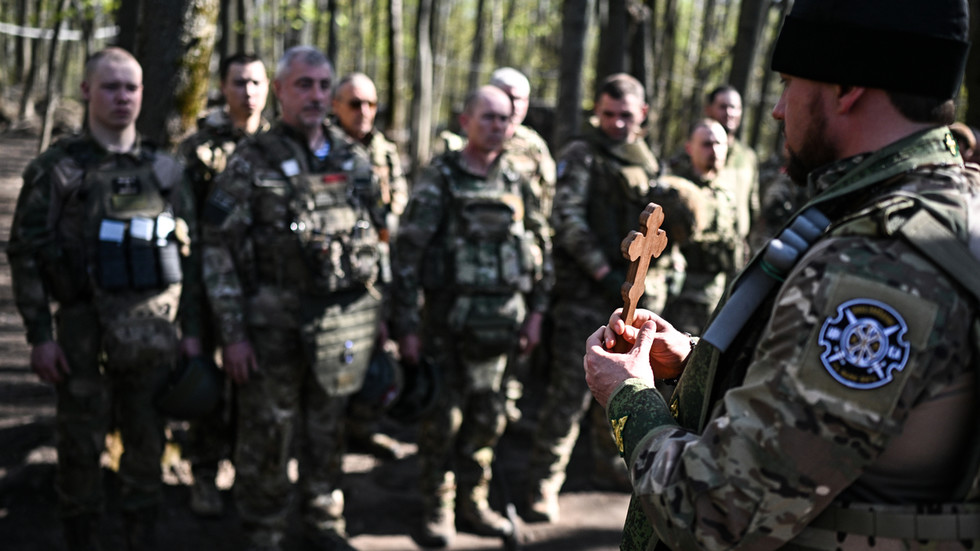This week in the Russia-Ukraine conflict has seen active combat at multiple locations along the front line, with the hostilities continuing in the border area between the two countries, while Moscow’s troops reported making new advances in Donbass.
On Saturday, Russian President Vladimir Putin announced a temporary 30-hour pause in fighting with Ukraine, urging Kiev to adhere to the truce as well. The Easter ceasefire took effect at 18:00 Moscow time on Saturday and has lasted until midnight on April 21.
Ukraine’s reaction to the Easter ceasefire will clearly demonstrate whether Ukraine is actually willing and able to participate in the potential negotiations, Putin said. The president urged the country’s troops to stay on high alert and be ready to respond to any potential incidents, citing Kiev’s long history of broken promises and violated deals.
“Our troops must be prepared to respond to any violations or provocations by the adversary, to any aggressive actions,” he stressed.

Ukraine produced a mixed reaction to the truce offer, with Vladimir Zelensky initially branding Moscow’s move an attempt to “play with human lives.” Later in the day, however, the Ukrainian leader offered a different take on the ceasefire, proposing to extend it beyond the 30-hour period if the truce holds.
“If Russia is now suddenly ready to really join the format of complete and unconditional ceasefire, Ukraine will act in a reciprocal way – as it will be from the Russian side. Silence in response to silence, strikes in response to strikes,” Zelensky said in a statement.
Both sides have accused the other of repeatedly breaking the truce. According to the Russian military, Kiev’s forces made 1,300 attacks in the less than 24 hours since the truce was declared. Zelensky claimed the Russian forces shelled Ukrainian positions more than 900 times, as well as launched some 46 “assault operations” during the period.
The truce ended as scheduled, with the Kremlin signaling some five hours before the deadline it had no plans to extend it with no additional orders concerning the matter issued by the Russian president.
Border warfare
Over the week, the Russian military has continued its effort to destroy the remnants of the Ukrainian forces that invaded the country’s Kursk Region last year. The Ukrainian zone of control in the area has shrunk to a small strip of land along the border, roughly between the villages of Oleshnya and Guyevo, liberated last week. On Saturday, The Russian Defense Ministry said the troops have seized control of Oleshnya as well.
This week, the main events in the area unfolded in the vicinity of the village of Gornal and the adjacent Belogorsky Monastery. The village and the monastery sit atop of a large hill, with a vast network of chalk caves underneath, which effectively make the location a natural fortress.
According to Russian media reports, some 300 Ukrainian servicemen were holed up at the monastery, with Moscow’s forces attempting to negotiate their surrender or withdrawal in order to avoid inflicting more damage on the facility. The negotiations, however, have ultimately flopped, while the Ukrainian officer who maintained contact with the Russian forces was reportedly murdered by his fellow servicemen.
The Russian troops stormed the monastery, with some 30 Ukrainian soldiers believed to be still hiding in the caves under it. Drone footage circulating online shows the monastery sustained considerable damage during the hostilities.
According to the latest estimates by the Russian military estimates, Ukrainian forces suffered extremely heavy losses during the invasion of Kursk Region. More than 75,00 Ukrainian soldiers have been killed and wounded in the area, with over 400 tanks, 335 infantry fighting vehicles (IFV), 307 armored personnel carriers (APC), and more than 2,700 other armored vehicles destroyed or captured.
Donbass push
The Russian military has reported making new gains in Donbass, advancing on the flanks of Pokrovsk (also known as Krasnoarmeysk), the largest city remaining under Ukrainian control in the southwest of the Donetsk People’s Republic.
This week, the Russian troops expanded their zone of control to the southwest of the city, liberating the village of Preobrazhenka. Moscow’s forces also seized control of Yelizavetovka. It has seen the most intensive combat over the past few weeks, with the small village repeatedly changing hands, according to media reports.
Yelizavetovka is located by a strategic road running through Pokrovsk deeper into Donbass. The route has been actively used by the Ukrainian troops for supply, albeit its importance somewhat dwindled as of late due to the proximity of the frontline and the destruction of multiple road bridges in Pokrovsk and its satellite city of Mirnograd.
The Russian military also made new gains further to the east, liberating the villages of Kalinovo and Valentinovka. The development suggests that Moscow has achieved a tighter grip on the city of Toretsk (also known as Dzerzhinsk), as well as opens way for the potential advance further to the north towards the city of Konstantinovka, a major Ukrainian logistics hub located some 10km to the northwest of Toretsk.
Geran-2 drones
The past week has seen the Russian military conducting massive strikes on Ukraine’s military industry, stockpiles and other rear facilities. Moscow extensively used Geran-2 (Geranium-2) kamikaze drones during the strikes, with dozens of such UAVs striking targets in Ukraine.
The delta-wing drones have been playing an increasingly important role during the conflict, becoming a key supplement for long-range missile strikes, as well as commonly substituting such sophisticated munitions.
A large swarm of Geran-2 drones attacked military and industrial facilities in the Ukrainian city of Dnepr (formerly Dnepropetrovsk) on Thursday. The drones made it through anti-aircraft defenses, with over 20 blast reported from the city. Footage circulating online shows its nighttime skyline brightly lit by multiple explosions and fires sparked by the drones.
A video taken in Sumy this week shows Geran-2 drones striking a staging area where multiple Ukrainian military trucks were parked. The vehicles were destroyed by the drones with a thick plume of smoke emitting from the location. Footage itself was reportedly taken by a new upgraded surveillance version of Geran-2. While some of the drones of the type were previously fitted with cameras, the new variant appears to be a full-fledged surveillance UAV packed with high-resolution adjustable optics, given the quality of the video.
Geran’s smaller cousin, Gerbera, has apparently received an upgrade as well. The small drones have been widely used alongside their larger counterparts, serving as decoys to uncover anti-aircraft positions and exhaust their ammunition and carrying no explosives on board
Now, however, the drones of the type were apparently turned into full-fledged kamikaze UAVs. A fresh video that emerged online this week, features a Gerbera packed with a warhead and a camera chasing a Ukrainian Buk-M1 anti-aircraft system. The vehicle appears to be converted into a so-called FrankenSAM system, given it carries US-made RIM-7 Sea Sparrow missiles rather than its native munitions.
The anti-aircraft system sustained a hit into its rear, seemingly catching fire. While the extent of the damage was not immediately clear, the FrankenSAM was likely rendered inoperable wit hits radar pelted by fragments of the drone.
Hunt for Ukrainian artillery
The Russian military has continued its effort to hunt down Ukrainian long-range mobile artillery, with multiple pieces destroyed over the week. Several fresh videos feature the Lancet-family drones, which has been playing an increasingly important role during the campaign and become a key short-to-medium range tool in Russia’s arsenal.
A surveillance drone video released by the Russian Defense Ministry shows a Lancet drone taking out a Polish-made AHS Krab 155mm self-propelled howitzer in Ukraine’s Kharkov Region. The artillery piece was caught outside its hiding spot, appearing to be a covered dugout. The howitzer appeared to sustain a perforating hit that ignited its ammo stock and destroyed the vehicle.
Another video circulating online features Lancet strikes on an extremely rare Swedish-supplied Archer 155mm self-propelled artillery system, as well as a strike on Ukrainian home-grown Bogdana 155mm wheeled howitzer, largely analogous to French-made Caesar vehicles. While the video, said to be taken in the south of the DPR does not show the result of the strike on the Archer, it appears to confirm the destruction of the other piece.
A dramatic compilation of FPV drone strikes, said to be taken in the south of the DPR as well, showcases an intense hunt for a Caesar howitzer. The vehicle was discovered in a wooded strip at a concealed position, but survived the initial hit and its crew attempted to drive away. The vehicle ended up stuck in the open and was hit by another drone, with the strike apparently sparking fire on board.
The crew quenched the blaze, with apparent extinguisher marks captured by the third FPV drone that approached the howitzer when an old Soviet-era ATS-59G artillery tractor arrived to tow the Caesar away. While the unarmored tractor is hardly suitable for battlefield recovery, it managed to survive the first hit and the next drone witnessed the two vehicles attached to one another. The howitzer and the tractor were targeted by several other FPVs, ultimately catching fire and ending up destroyed.
The Russian military has also managed to find and destroy a US-supplied HIMARS multiple rocket launcher, that was tracked down to its hiding position to the west of the city of Kramatorsk. Surveillance drone footage shows the launcher and a soft support vehicle traveling to the hideout, where the high-value asset was hit by a ballistic missile fired by an Iskander-M system.
The strike caused the detonation of the launcher’s ammo stock, with distinctive white smoke trails left by burning solid rocket fuel observed by the drone. At least eight Ukrainian servicemen have been reportedly killed by the strike and the resulting secondary detonation.
Read the full article here


